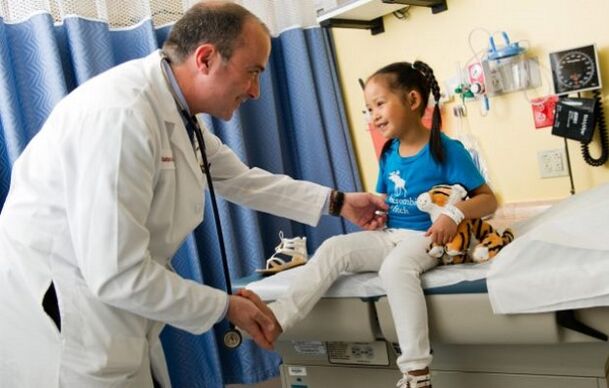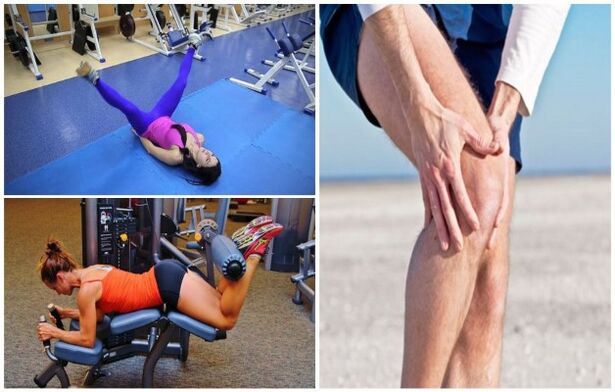Arthrosis of the hip joint is a disease of the musculoskeletal system with a progressive course and a chronic nature. Dystrophic alterations start in the cartilaginous tissue, which changes its structure, becomes loose, fibrous, becomes thinner and loses its amortization function. As a result, the bony joints start rubbing against each other, motor activity is lost and pain occurs. In the absence of treatment, the person becomes disabled.
Clinical picture and causes of arthrosis
Arthrosis of the hip joint occupies a prominent position among diseases of the musculoskeletal system and affects mainly the adult population from 35 years of age onwards. In the medical classifier, it was assigned the code M16 according to MBK 10.
The hip joint is the largest in the human body and receives the greatest load. It connects the bones to the pelvis and has a spherical appearance. The round head of the femur is inserted into the acetabular notch. Its surface is covered by cartilaginous tissue, which allows the bones to slide and performs shock absorbing functions, protecting the bones from friction, destruction and providing a range of motion.
The mechanism of arthrosis is simple:
- The amount of synovial fluid decreases, as a result of which the joint is made worse by it, and the supply of nutrients decreases.
- The joint structure becomes loose. Due to friction, the cartilage becomes thinner, no longer reducing the pressure on the bones.
- Growths (osteophytes) are formed along the edges of bony sites.
- The gap in the joint is gradually reduced.
- The person feels severe pain, movement problems, the limb shortens, causing lameness.
Hip arthrosis can develop for a variety of reasons, but is most often caused by a combination of adverse circumstances. The disease is divided into primary and secondary. In the first case, doctors do not find the reason for the development of the disease; in the second, there is arthrosis due to certain pathologies.

Main reasons:
- trauma;
- force loads, especially in the post-traumatic period, when the joint has not yet recovered;
- overweight;
- congenital anomaly of the femoral head (dysplasia);
- heredity;
- arthritis (inflammation of the joints);
- prolonged stress;
- hormonal changes and diseases of the endocrine system;
- infectious diseases.

Arthrosis can be unilateral, with damage to the right or left hip joint. More often, there is a bilateral option when the pathological process affects both sides.
Symptoms and degrees of arthrosis
The clinic of arthrosis depends directly on the stage of the disease. At first, the person begins to experience mild discomfort in the groin and morning stiffness in the leg, while swelling and swelling of the soft tissue does not occur. As the pathology develops, an acute period begins, characterized by severe pain.
On a note. When the first symptoms are found, you should see a doctor and get tested. The initial disease responds well to treatment.
The main complaint of all patients is pain and difficulty in walking. Its severity depends on dystrophic changes in cartilage.
There are 3 degrees of the disease:
- At 1 degree, only discomfort appears after prolonged physical effort (climbing hills, running, cycling), which disappears on its own after rest. Muscles are in good shape, movement is not limited. A narrowing of the joint space can be seen on x-ray.
- At 2 degrees, the pain starts, which is given in the groin area, spreading to the buttocks and the front of the thigh. There are "initial" pains when trying to get up or start walking, which disappears after 2-3 minutes. After prolonged effort, the pain increases and disappears at rest. A symptom of arthrosis is a characteristic click of the joint, movement is limited (hip abduction), muscle strength decreases, with painful sensations, smooth muscle spasm occurs. On radiography, small osteophytes are visible, located along the edges of the bony areas of the joints. The femoral neck is thickened and widened, the joint space is significantly narrowed.
- In the 3 degrees of the disease, the pain is permanent and does not stop even at rest. When walking, patients use improvised objects (cane, crutch). There is atrophy of the muscle tissue in the thigh and leg, the limb is shortened - to reach the ground, the patient is forced to stand on his fingertips. The radiograph shows massive osteophytes, the flattened femoral head, the joint space practically invisible.
Some doctors also distinguish the 4th degree of the disease. Ossification of the joint and complete deficiency in it, a person cannot move without the help of crutches. The degree of arthrosis is established based on X-ray images, which help to clarify the etiology of the pathological process.
The following types of arthrosis are distinguished:
- dysplastic - the slope of the acetabulum is determined;
- post-traumatic - depends on the nature of the injury and the shape of the joint after bone fusion.
childhood arthrosis
The causes of pathology in children are trauma, subluxation and dysplasia. Metabolic disturbances can lead to cartilage tissue destruction.
The main symptom of the disease in children is the pain syndrome after long games. As osteoarthritis develops, they become more intense and stronger. The child refuses to run, appetite decreases, excessive crying appears. The second symptom is limited movement in the affected joint, numbness in the leg. Parents need to pay attention to the characteristic crisis. If the first symptoms are found, it is necessary to see a doctor urgently.
On a note. A child's body regenerates faster than an adult's. Timely treatment will save the child from disability.
If the diagnosis is confirmed, the main goal is to improve the blood supply to the joint. For this, the doctor prescribes various physical therapy procedures, exercise therapy, visits to sanatoriums, medications.

Prevention consists of proper nutrition. Particularly important are the group B, C, D vitamins. It is necessary to walk a lot in the open air, to move actively and to avoid traumatic situations.
Difference between arthrosis and other joint diseases
Many patients, when they hear the diagnosis "arthrosis", confuse it with other joint diseases. Often, physicians in medical history make a note of "coxarthrosis. "Consonant words confuse the patient.
Arthrosis is the general name for the pathological processes that cause the destruction of cartilage tissue. It usually disappears with joint deformity, without infectious and inflammatory processes. It can affect the knee, elbow, shoulder and other joints. A coxarthrosis is an arthrosis of the hip joint, indicated by the prefix "cox", which highlights a specific area.
What is the difference between sacroiliitis and osteoarthritis? In the first case, inflammation of the sacroiliac joint occurs, which is characterized by pain in the sacrum when sitting. There is swelling in the vertebrae, pain in the buttocks. With arthrosis, thinning of the cartilage occurs, which results in friction in the bones - which causes pain.
Arthritis is an inflammatory process in joint tissue. The difference with osteoarthritis is that it is caused by mechanical movements that lead to cartilage abrasion. In arthritis, there is swelling and redness in the joint region, the cause is infectious diseases or inflammatory processes within the body. The reactive stage of the disease almost always causes osteoarthritis. The pain sensations are similar, but with coxarthrosis they lessen at night and with arthritis they are stronger.
The clinical picture is similar. To correctly diagnose and rule out arthritis and sacroiliitis, doctors perform a blood sampling and analysis. An increased content of leukocytes and ESR indicates an inflammatory process in the body.
Diet
With osteoarthritis, a complex and long-term treatment is needed, based on medication, physiotherapy, exercise therapy and massage, while diet plays an important role. Adequate nutrition is needed in both the exacerbation and remission stages. It must be balanced and contain all the essential vitamins. In addition, diet promotes weight loss, which reduces joint stress.
Allowed products:
- vegetables and fruits;
- lean meats;
- crumbly porridge in water;
- dairy products;
- bran bread;
- a fish;
- Honey;
- mushrooms;
- nuts.
The menu should include gelatin. Based on it, you can make various fruit and berry desserts, as well as frozen meats. Eat cottage cheese, yogurt and milk daily. It is better to replace chicken eggs with quail eggs. Boil, simmer over low heat or steam. Eliminate fried and fatty foods. Give preference to vegetable oils. Drink at least 1. 5 clean water a day. Food temperature should not be too high or too low.

Avoid quick snacks with sweet sparkling water. Excludes semi-finished products, sausages, preserves. Prefer natural products without added preservatives.
What is prohibited:
- pickles;
- smoked products;
- white bread and baked goods;
- hot spices;
- garlic;
- radish;
- fatty meats;
- Salo;
- canned food;
- Mayo;
- high-fat dairy products;
- carbonated beverages;
- alcohol.
Important. Food intake should be frequent, at least 5-6 times a day, 200 grams. Snacks are best made with your favorite fruits, you can have a glass of kefir in the evening. Diet should not exceed 2, 000 kcal for women and 3, 000 kcal for men.

Prophylaxis
Preventive measures consist of timely elimination of the root causes of the disease and general strengthening measures.
To prevent the development of the disease, you must follow the following rules:
- To live an active lifestyle. Swimming, exercise without stress on the joints is recommended. Preventive methods include bathing and sauna, which improve blood flow and remove toxins.
- Follow a diet. This is necessary to provide the body with the necessary vitamins and speed up metabolic processes.
- Avoid hypothermia. Low temperatures cause muscle cramps, which impair the blood supply to the joint.
- To minimize the possibility of trauma, especially with the development of coxarthrosis.
Subject to the rules, patient ratings were positive. They noted a decrease in pain, restoration of joint mobility and an improvement in well-being.

Hip osteoarthrosis or hip arthrosis is a disease with a chronic course, with phases of exacerbation and remission. The timely treatment allows to interrupt the dystrophic process in the cartilaginous tissue and maintain the mobility of the legs. In the absence of therapy, the person is incapacitated, in which case only surgery and joint replacement can restore the musculoskeletal system.

























